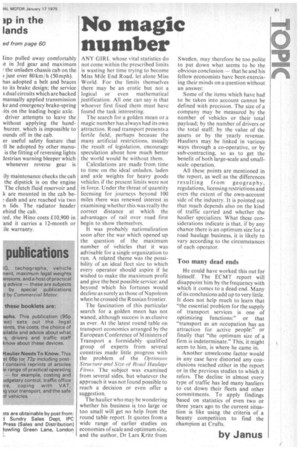No magic number
Page 63

If you've noticed an error in this article please click here to report it so we can fix it.
ANY GIRL whose vital statistics do not come within the prescribed limits is wasting her time trying to become Miss Mile End Road, let alone Miss World. For the limits themselves there may be an erotic but not a logical or even mathematical justification. All one can say is that whoever first fixed them must have found the task interesting.
The search for a golden mean or a magic number has always had its own attraction. Road transport presents a fertile field, perhaps because the many artificial restrictions, usually the result of legislation, encourage speculation about how much better the world would be without them.
Calculations are made from time to time on the ideal unladen, laden and axle weights for heavy goods vehicles if the present limits were not in force. Under the threat of quantity licensing for journeys beyond 100 miles there was renewed interest in examining whether this was really the correct distance at which the advantages of rail over road first begin to show themselves.
It was probably nationalization soon after the war which opened up the question of the maximum number of vehicles that it was advisable for a single organization to run. A related theme was the possibility of an ideal fleet size to which every operator should aspire if he wished to make the maximum profit and give the best possible service: and beyond which his fortunes would decline as surely as those of Napoleon when he crossed the Russian frontier.
The fascination of this particular search for a golden mean has not waned, although success is as elusive as ever. At the latest round table on transport economics arranged by the European Conference of Ministers of Transport a formidably qualified group of experts from several countries made little progress with the problem of the Optimum Structure and Size of Road Haulage Firms. The subject was examined from several sides, but whatever the approach it was not found possible to reach a decision or even offer a suggestion.
The haulier who may be wondering whether his business is too large or too small will get no help from the round table report. It quotes from a wide range of earlier studies on economies of scale and optimum size, and the author, Dr Lars Kritz from Sweden, may therefore be too polite to put down what seems to be the obvious conclusion — that he and his fellow economists have been exercising their minds on a question without an answer.
Some of the items which have had to be taken into account cannot be defined with precision. The size of a company may be measured by the number of vehicles or their total payload; by the number of drivers or the total staff; by the value of the assets or by the yearly revenue. Hauliers may be linked in various ways through a co-operative, or by sub-contracting, so as to get the benefit of both large-scale and smallscale operation.
All these points are mentioned in the report, as well as the differences resulting from geography, regulations, licensing restrictions and even the extent of the own-account side of the industry. It is pointed out that much depends also on the kind of traffic carried and whether the haulier specializes. What these considerations indicate is that, if by any chance there is an optimum size for a road haulage business, it is likely to vary according to the circumstances of each operator.
Too many dead ends
He could have worked this out for himself. The ECMT report will disappoint him by the frequency with which it comes to a dead end. Many of its conclusions add up to very little. It does not help much to learn that "the essential problem for the supply of transport services is one of optimizing functions:" or that "transport as an occupation has an attraction for active people:" or finally that "the optimum size of a firm is indeterminate." This, it might seem to him, is where he came in.
Another unwelcome factor would in any case have distorted any conclusions reached either in the report or in the previous studies to which it refers. The decline in almost every type of traffic has led many hauliers to cut down their fleets and other commitments. To apply findings based on statistics of even two or three years ago to the current situation is like using the criteria of a beauty competition to find the champion at Crufts.
by Janus
























































































































